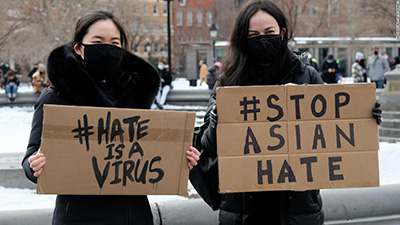
Our March blog post was written by Jenny Lee Northey, Career Counsellor. In this piece, she talks about the importance of language when doing anti-racist work.
As we mark the one-year anniversary of the World Health Organization’s declaration of a global pandemic, we have witnessed how the pandemic has highlighted and exacerbated all types of longstanding inequities in our society. In the early months of 2020 as the novel coronavirus spread, overt discrimination and acts of racism towards Asian communities spiked as people associated COVID-19 with people of Asian descent. There was heightened fear and anxiety, not only with the uncertainty of the coronavirus itself, but of the growing anti-Asian sentiment.
As the pandemic continues, we have seen anti-Asian racism and hate crimes continue to persist. There has been heightened media coverage of recent violent and fatal attacks on people of Asian descent, including an 84-year-old Thai American man who died of his injuries after being brutally shoved in San Francisco, a Montreal stabbing, as well as reports of verbal harassment and physical assault of frontline workers and business owners, amongst other incidents. While Canadians often claim that our country does not have the same level of race-based violence, the city of Vancouver reported a sevenfold increase of anti-Asian hate crimes in 2020, and other major Canadian cities such as Toronto and Montreal have seen similar spikes. In April 2020, concerned by the lack of news media coverage on Anti-Asian racism and data collection, individual organizations such as the Chinese Canadian National Council – For Social Justice (CCNC-SJ) and Project 1907 began their own work to report and track incidents across Canada.
These incidents and hate crimes corresponded to the rise of racist rhetoric, fuelled by inflammatory racist headlines and deliberate usage of the label “Chinese virus” or “Wuhan virus”. As Viala-Gaudefroy and Lindaman describes, using the word “Chinese” to describe the virus personifies the infection and associates it with a specific country and ethnicity, creating an “othering” effect that “stokes anxiety, resentment, fear and disgust toward people associated with that group.” Asian Canadian communities also recall similar xenophobia and racism they faced in the early 2010s related to SARS and the H5N1 bird flu.
This use of language is not novel, in the longstanding history of anti-immigrant rhetoric and policy towards immigrants of Asian descent in both Canada and the United States. Part of the intent of the Chinese Immigration Act of 1885 was to limit the “spread of disease” as the Chinese were often seen to be carriers of infections and disease and to further limit the influx of the “yellow peril”, despite the essential contribution of Chinese labour to the early economic development of the west coast of North America. Chinese people were seen as “dangerous to the white” and often described and labelled as “dirty” and “disgusting” and living with a “standard of morality immeasurably beyond ours”, as outlined in the 1885 Report of the Royal Commission on Chinese Immigration.
What we give language to shapes our narrative and worldview, and it is particularly in the midst of fear that language can be wielded as a weapon to further divide and alienate people from one another, further normalizing and institutionalizing racism and discrimination into our societal structures. Over this past year, we have seen how language around race and identity has been critically re-examined for the ways in which they can further marginalize individuals and groups of people, even erasing the differences that should be acknowledged and celebrated. As we continue to advocate for racial justice and equity for all, we need to continually be critical-minded and vigilant of how language is employed in shaping a more equitable, instead of divisive, post-pandemic world.
Sources
“Chinese Immigration Act.” The Canadian Encyclopedia, http://www.thecanadianencyclopedia.ca/en/article/chinese-immigration-act. Accessed 15 Mar. 2021.
Chung, Amy. “In 2021, Asian Canadians Document Hate Crimes To Be Believed.” HuffPost Canada, 3 Mar. 2021, http://www.huffingtonpost.ca/entry/anti-asian-racism-canada_ca_603d08cdc5b682971502118f.
Larsson, Paula. “Anti-Asian Racism during Coronavirus: How the Language of Disease Produces Hate and Violence.” The Conversation, 31 Mar. 2020, http://theconversation.com/anti-asian-racism-during-coronavirus-how-the-language-of-disease-produces-hate-and-violence-134496.
“The Chinese Immigration Act, 1885 | Pier 21.” The Canadian Museum of Immigration at Pier 21, http://pier21.ca/research/immigration-history/the-chinese-immigration-act-1885. Accessed 15 Mar. 2021.
Viala-Gaudefroy, Jérôme, and Dana Lindaman. “Donald Trump’s ‘Chinese Virus’: The Politics of Naming.” The Conversation, 21 Apr. 2020, http://theconversation.com/donald-trumps-chinese-virus-the-politics-of-naming-136796.